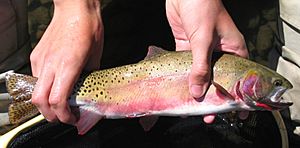Rio Grande cutthroat trout facts for kids
The Rio Grande cutthroat trout (Oncorhynchus clarki virginalis) is a special type of cutthroat trout. It belongs to the family Salmonidae, which includes salmon and other trout. You can find this fish in the northern parts of New Mexico and southern Colorado. It lives in the smaller rivers and streams that flow into the big Rio Grande river.
Quick facts for kids Rio Grande cutthroat trout |
|
|---|---|
 |
|
| Rio Grande cutthroat trout from the Conejos watershed in southern Colorado | |
| Scientific classification |
|
| Kingdom: | Animalia |
| Phylum: | Chordata |
| Class: | Actinopterygii |
| Order: | Salmoniformes |
| Family: | Salmonidae |
| Genus: | Oncorhynchus |
| Species: | |
| Subspecies: |
O. c. virginalis
|
| Trinomial name | |
| Oncorhynchus clarkii virginalis (C. F. Girard, 1856)
|
|
This trout is one of 14 different types, or subspecies, of cutthroat trout found in the western United States. It's also the official state fish of New Mexico! Long ago, in 1541, a Spanish explorer named Francisco de Coronado saw trout in the Pecos River. These were likely Rio Grande cutthroat trout.
Contents
Life Cycle and Appearance
When Do They Reproduce?
Rio Grande cutthroat trout usually spawn, or lay their eggs, between the middle of May and the middle of June. Male trout are ready to reproduce when they are about two years old. Females mature a little later, usually at three years old.
How Long Do They Live?
These trout typically live for about five years. But sometimes, if they are very lucky, they can live much longer, even into their teens!
What Do They Eat?
Rio Grande cutthroat trout are not picky eaters. They eat whatever they can find! Their diet mostly includes aquatic insects that live in the water. They also munch on terrestrial insects that fall into the stream from the land above.
What Do They Look Like?
Rio Grande cutthroat trout have unique spots. Their spots are not perfectly round and are mostly found behind their dorsal fin (the fin on their back). They have fewer, smaller spots above their lateral line (a line along their side) towards their head.
Their bodies can be a light rose or red-orange color on the sides. Their bellies are often pink or yellow-orange.
Conservation Efforts
Where Do They Live Now?
The Rio Grande cutthroat trout is the southernmost type of cutthroat trout. This means it lives further south than any other cutthroat subspecies. While there were once reports of them in Mexico and Texas, it's not clear how far south they truly lived. Today, the furthest south known populations are in the Gila Mountains of Southern New Mexico.
These trout currently live in about 700 miles of stream within the Santa Fe National Forest. This is about 91% of the area where they historically lived.
Are They Endangered?
From 2008 to 2014, the Rio Grande cutthroat trout was considered for protection under the Endangered Species Act. This act helps protect animals that are at risk of disappearing forever. However, in 2014, it was decided that this species did not need to be listed as endangered. This was good news, showing that conservation efforts were helping.
Their Natural Neighbors
The Rio Grande cutthroat trout grew up in New Mexico alongside other native fish. These include the longnose dace, the Rio Grande chub, and the Rio Grande sucker. They all share the same watery homes.

